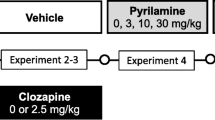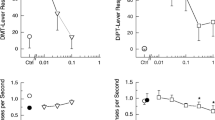Abstract
Rationale
To examine the functional relationship between 5-HT1B receptors (5-HT1B-R) and 5-HT2C receptors (5-HT2C-R) in the control of food intake.
Objectives
To compare the hypophagic effect of the 5-HT2C/1B-R agonist m-chlorophenylpiperazine (mCPP), with that of the selective 5-HT1B-R agonist CP-94,253 in both wildtype (WT) and 5-HT2C knockout (KO) mice.
Methods
The hypophagic effects of mCPP (1, 3 and 5.6 mg/kg) and CP-94,253 (5, 10 and 20 mg/kg) were assessed in WT and 5-HT2C KO mice using the behavioural satiety sequence paradigm. The effects of pre-treatment with the selective 5-HT2C-R antagonist SB 242,084 (0.5 and 1.5 mg/kg) were assessed in two groups of WT mice, with each group given only mCPP or CP-94,253.
Results
The 5-HT2C/1B receptor agonist mCPP and the selective 5-HT1B receptor agonist CP-94,253 both suppressed food intake in WT mice. 5-HT2C KO mice were insensitive to the hypophagic effects of mCPP but were more sensitive to CP-94,253-induced hypophagia than WT controls. mCPP induced a significant increase in post-prandial activity in 5-HT2C KO mice, but this effect was absent in 5-HT2C KO mice who were given CP-94,253. Data from WT mice, who were pre-treated with the 5-HT2C receptor antagonist SB 242,084 and then challenged with either mCPP or CP-94,253, were similar to those obtained from 5-HT2C KO mice.
Conclusions
5-HT2C-R and 5-HT1B-R activation are each sufficient to induce a hypophagic response. However, concurrent 5-HT2C-R inactivation can potentiate the hypophagic response to 5-HT1B-R activation, consistent with an inhibitory role for the 5-HT2C-R in behaviour mediated by the activation of other 5-HT receptors. These results also confirm that 5-HT1B-R activation alone cannot account for the hyperactive response of 5-HT2C KO mice to mCPP.








Similar content being viewed by others
References
Antin J, Gibbs J, Holt J, Young RC, Smith GP (1975) Cholecystokinin elicits the complete behavioural sequence of satiety in rats. J Comp Physiol Psychol 89:784–790
Baumann MH, Rutter JJ, Auerbach SB (1993) Intravenous administration of the serotonin agonist m-chlorophenylpiperazine (mCPP) increases extracellular serotonin in the diencephalon of awake rats. Neuropharmacology 32:1381–1386
Bendotti C, Samanin R (1987) The role of putative 5-HT1A and 5-HT1B receptors in the control of feeding in rats. Life Sci 41:635–642
Blundell JE (1977) Is there a role for serotonin (5-hydroxytryptamine) in feeding? Int J Obes 1:15–42
Boess FG, Martin IL (1994) Molecular biology of 5-HT receptors. Neuropharmacology 33:275–317
Clifton PG (1994) The neuropharmacology of meal patterning. In: Cooper SJ, Hendrie CA (eds) Ethology and Psychopharmacology. Wiley, UK, pp313–328
Clifton PG, Lee MD, Dourish CT (2000) Similarities in the action of Ro 60-0175, a 5-HT2C receptor agonist and d-fenfluramine on feeding patterns in the rat. Psychopharmacology (Berl) 152(3):256–267
Clifton PG, Lee MD, Somerville EM, Kennett GA, Dourish CT (2003) 5-HT1B receptor knockout mice show a compensatory reduction in 5-HT2C receptor function. Eur J Neurosci 17:185–190
Dalton GL, Lee MD, Kennett GA, Dourish CT, Clifton PG (2004) mCPP-induced hyperactivity in 5-HT2C receptor mutant mice is mediated by activation of multiple 5-HT receptor subtypes. Neuropharmacology 46:663–671
De Vry J, Jentzsch KR, Schreiber R (1999) Effects of selective 5-HT1/2 receptor agonists on operant food intake in rats. Behav Pharmacol 10:S26
De Vry J, Schreiber R, Daschke A, Jentzsch KR (2003) Effects of serotonin 5-HT(1/2) receptor agonists in a limited-access operant food intake paradigm in the rat. Eur Neuropsychopharmacol 13(5):337–345
Dourish CT, Clark ML, Fletcher A, Iversen SD (1989) Evidence that blockade of post-synaptic 5-HT1 receptors elicits feeding in satiated rats. Psychopharmacology (Berl) 97(1):54–58
Fletcher A, Davies DT (1990) The involvement of 5-hydroxytryptaminergic and dopamine mechanisms in the eating induced by buspirone, gepirone and ipsapirone. Br J Pharmacol 99:519–525
Fletcher PJ, Chintoh AF, Sinyard J, Higgins GA (2004) Injection of the 5-HT2C receptor agonist Ro60-0175 into the ventral tegmental area reduces cocaine-induced locomotor activity and cocaine self-administration. Neuropsychopharmacology 29:308–318
Garattini S, Mennini T, Bendotti C, Invernizzi R, Samanin R (1986) Neurochemical mechanism of action of drugs which modify feeding via the serotonergic system. Appetite 7 [Suppl]:15–38
Gommans J, Hijzen TH, Maes RA, Olivier B (1998) Discriminative stimulus properties of mCPP: evidence for a 5-HT2C receptor mode of action. Psychopharmacology (Berl) 137:292–302
Halford JC, Blundell JE (1996) The 5-HT1B receptor agonist CP-94,253 reduces food intake and preserves the behavioural satiety sequence. Physiol Behav 60:933–939
Halford JC, Wanninayake SC, Blundell JE (1998) Behavioral satiety sequence (BSS) for the diagnosis of drug action on food intake. Pharmacol Biochem Behav 61:159–168
Hayashi A, Sonoda R, Kimura Y, Takasu T, Suzuki M, Sasamata M, Miyata K (2004) Antiobesity effect of YM348, a novel 5-HT2C receptor agonist, in Zucker rats. Brain Res 1011:221–227
Heisler LK, Tecott LH (2000) A paradoxical locomotor response in serotonin 5-HT(2C) receptor mutant mice. J Neurosci 20:RC71
Heisler LK, Chu H-M, Tecott LH (1998) Epilepsy and obesity in serotonin 5-HT2C receptor mutant mice. Ann NY Acad Sci 861:74–78
Hewitt KN, Lee MD, Dourish CT, Clifton PG (2002) Serotonin 2C receptor agonists and the behavioural satiety sequence in mice. Pharmacol Biochem Behav 71:691–700
Higgins GA, Ouagazzal AM, Grottick AJ (2001) Influence of the 5-HT(2C) receptor antagonist SB242,084 on behaviour produced by the 5-HT(2) agonist Ro60-0175 and the indirect 5-HT agonist dexfenfluramine. Br J Pharmacol 133:459–466
Jones N, Duxon MS, King SM (2002) 5-HT2C receptor mediation of unconditioned escape behaviour in the unstable elevated exposed plus maze. Psychopharmacology (Berl) 164:214–220
Kennett GA, Curzon G (1988) Evidence that hypophagia induced by mCPP and TFMPP requires 5-HT1C and 5HT1B receptors; hypophagia induced by RU 24969 only requires 5-HT1B receptors. Psychopharmacology (Berl) 96:93–100
Kennett GA, Lightowler S, de Biasi V, Stevens NC, Wood MD, Tulloch IF, Blackburn TP (1994) Effect of chronic administration of selective 5-hydroxytryptamine and noradrenaline uptake inhibitors on a putative index of 5-HT2C/2B receptor function. Neuropharmacology 33:1581–1588
Kennett GA, Wood MD, Bright F, Trail B, Riley G, Holland V, Avenell KY, Stean T, Upton N, Bromidge S, Forbes IT, Brown AM, Middlemiss DN, Blackburn TP (1997) SB 242084, a selective and brain penetrant 5-HT2C receptor antagonist. Neuropharmacology 36:609–620
Kitchener SJ, Dourish CT (1994) An examination of the behavioural specificity of hypophagia induced by 5-HT1B, 5HT1C and 5HT2 receptor agonists using the post-prandial satiety sequence in rats. Psychopharmacology (Berl) 113:369–377
Koe KB, Neilsen JA, Macor JE, Heym J (1992) Biochemical and behavioural studies of the 5-HT1B receptor agonist CP-94,253. Drug Dev Res 26:241–250
Lee MD, Simansky KJ (1997) CP-94, 253: a selective serotonin1B (5-HT1B) agonist that promotes satiety. Psychopharmacology (Berl) 131:264–270
Lee MD, Aloyo VJ, Fluharty SJ, Simansky KJ (1998) Infusion of the serotonin1B (5-HT1B) agonist CP-93,129 into the parabrachial nucleus potently and selectively reduces food intake in rats. Psychopharmacology (Berl) 136:304–307
Lee MD, Kennett GA, Dourish CT, Clifton PG (2002) 5-HT1B receptors modulate components of satiety in the rat: behavioural and pharmacological analyses of the selective serotonin1B agonist CP-94,253. Psychopharmacology 164:49–60
Lee MD, Somerville EM, Kennett GA, Dourish CT, Clifton PG (2004a) Tonic regulation of satiety by 5-HT1B receptors in the mouse: converging evidence from behavioural and c-fos immunoreactivity studies. Eur J Neurosci 19:3017–3025
Lee MD, Somerville EM, Kennett GA, Dourish CT, Clifton PG (2004b) Reduced hypophagic effects of d-fenfluramine and the 5-HT(2C) receptor agonist mCPP in 5-HT(1B) receptor knockout mice. Psychopharmacology 176:39–49
Lopez-Gimenez JF, Tecott LH, Palacios JM, Mengod G, Vilaro MT (2002) Serotonin 5-HT (2C) receptor knockout mice: autoradiographic analysis of multiple serotonin receptors. J Neurosci Res 67:69–85
Lucas JJ, Yamamoto A, Scearce-Levie K, Saudou F, Hen R (1998) Absence of fenfluramine-induced anorexia and reduced cFos induction in the hypothalamus and central amygdaloid complex of serotonin 1B receptor knock-out mice. J Neurosci 18:5537–5544
Nonogaki K, Strack AM, Dallman MF, Tecott LH (1998) Leptin-independent hyperphagia and type 2 diabetes in mice with a mutated serotonin 5-HT2C receptor gene. Nat Med 4:1152–1156
Schreiber R, De Vry J (1999) Effects of 5-HT1/2 receptor agonists on dark-phase injestive behaviour in rats. Behav Pharmacol 10:S82
Schreiber R, De Vry J (2002) Role of 5-HT2C receptors in the hypophagic effect of m-CPP, ORG 37684 and CP-94,253 in the rat. Prog Neuropsychopharmacol Biol Psychiatry 26:441–449
Simansky KJ (1996) Serotonergic control of the organization of feeding and satiety. Behav Brain Res 73:37–42
Simansky KJ, Nicklous DM (2002) Parabrachial infusion of d-fenfluramine reduces food intake. Blockade by the 5-HT (1B) antagonist SB-216641. Pharmacol Biochem Behav 71:681–690
Simansky KJ, Vaidya AH (1990) Behavioral mechanisms for the anorectic action of the serotonin (5-HT) uptake inhibitor sertraline in rats: comparison with directly acting agonists. Brain Res Bull 25(6):953–960
Vickers SP, Clifton PG, Dourish CT, Tecott LH (1999) Reduced satiating effect of d-fenfluramine in serotonin 5-HT(2C) receptor mutant mice. Psychopharmacology (Berl) 143:309–314
Vickers SP, Benwell KR, Porter RH, Bickerdike MJ, Kennett GA, Dourish CT (2000) Comparative effects of continuous infusion of mCPP, Ro 60-0175 and d-fenfluramine on food intake, water intake, body weight and locomotor activity in rats. Br J Pharmacol 130(6):1305–1314
Vickers SP, Easton N, Malcolm CS, Allen NH, Porter RH, Bickerdike MJ, Kennett GA (2001) Modulation of 5-HT(2A) receptor-mediated head-twitch behaviour in the rat by 5-HT(2C) receptor agonists. Pharmacol Biochem Behav 69:643–652
Acknowledgements
The authors gratefully acknowledge Dr. Laurence Tecott of UCSF for kindly donating the original breeding stock of 5-HT2C knockout mice; Dr. N. Carey and A. Kalli of Vernalis Research Ltd for genotyping; and Linda Penfold for her excellent care of our animals. This research was funded by a University of Sussex graduate teaching assistantship with additional funding from Vernalis Research Ltd (GD) and by a BBSRC LINK project grant 85/LKD12007 (MDL).
Author information
Authors and Affiliations
Corresponding author
Rights and permissions
About this article
Cite this article
Dalton, G.L., Lee, M.D., Kennett, G.A. et al. Serotonin 1B and 2C receptor interactions in the modulation of feeding behaviour in the mouse. Psychopharmacology 185, 45–57 (2006). https://doi.org/10.1007/s00213-005-0212-3
Received:
Accepted:
Published:
Issue Date:
DOI: https://doi.org/10.1007/s00213-005-0212-3




